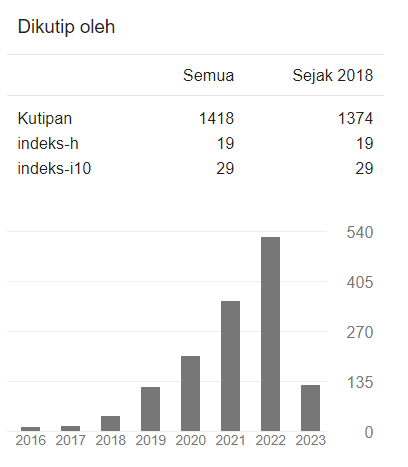Penerapan Media Game Ular Tangga Digital untuk Meningkatkan Hasil Belajar Tematik
DOI:
https://doi.org/10.22219/jp2sd.v8i2.12329Keywords:
digital snakes ladder, learning outcomesAbstract
Kurikulum 2013 lebih menekankan keaktifan peserta didik, namun penerapan pembelajaran masih berpusat pada guru. Salah satu penyebab adalah kurangnya penggunaan media pembelajaran. Oleh sebab itu perlu dilakukan upaya dalam meningkatkan kualitas pembelajaran. Penelitian ini bertujuan untuk meningkatkan hasil belajar dan menumbuhkan keaktifan siswa dengan penggunaan media ular tangga digital. Metode penelitian tindakan kelas digunakan dalam penelitian ini. Subjek penelitian siswa kelas IV berjumlah 35 siswa. Penelitian ini dilakukan dengan 2 siklus, yang terdiri dari perencanaan, pelaksanaan, pengamatan, dan refleksi. Siklus 2 dilakukan, apabila pada siklus 1 belum mencapai indikator keberhasilan pembelajaran. Pengumpulan data dan analisis data dilakukan dari hasil pelaksanaan pembelajaran dan observasi yang dilakukan kolaborator. Hasil penelitian menunjukkan adanya peningkatan hasil belajar dan perubahan sikap dengan penggunaan media game ular tangga digital. Peningkatan tersebut dibuktikan dengan angka rata-rata siklus 1, yaitu 74,42 meningkat menjadi 84,02 pada siklus 2, artinya terjadi peningkatan 9,6. Dengan demikian dapat disimpulkan bahwa media ular tangga digital dapat meningkatkan hasil belajar dan adanya perubahan aktivitas siswa pada proses pembelajaran. Hal ini dapat dikatakan bahwa pembelajaran dengan menggunakan media baik itu ular tangga digital maupun media pembelajaran lainnya dapat mengubah pembelajaran menjadi lebih aktif
Downloads
References
Afandi, R. (2015). Pengembangan Media Pembelajaran Permainan Ular Tangga Untuk Meningkatkan Motivasi Belajar Siswa dan Hasil Belajar IPS di Sekolah Dasar. JINoP (Jurnal Inovasi Pembelajaran), 1(1), 77. https://doi.org/10.22219/jinop.v1i1.2450
Alial-Sahel, R. (2005). Teachers’ perceptions of underachievement in elementary schools in Kuwait. School Psychology International, 26(4), 478–493. https://doi.org/10.1177/0143034305059027
Andres, H. P., & Petersen, C. (2002). Presentation Media, Information Complexity, and Learning Outcomes. Journal of Educational Technology Systems, 30(3), 225–246. https://doi.org/10.2190/3twa-nva7-0mew-402j
Bawa, P., Lee Watson, S., & Watson, W. (2018). Motivation is a game: Massively multiplayer online games as agents of motivation in higher education. Computers and Education, 123, 174–194. https://doi.org/10.1016/j.compedu.2018.05.004
Behnamnia, N., Kamsin, A., & Ismail, M. A. B. (2020). The landscape of research on the use of digital game-based learning apps to nurture creativity among young children: A review. Thinking Skills and Creativity, 37(May), 100666. https://doi.org/10.1016/j.tsc.2020.100666
Behnamnia, N., Kamsin, A., Ismail, M. A. B., & Hayati, A. (2020). The effective components of creativity in digital game-based learning among young children: A case study. Children and Youth Services Review, 116(June). https://doi.org/10.1016/j.childyouth.2020.105227
Delcourt, M. A. B., Cornell, D. G., & Goldberg, M. D. (2007). Cognitive and affective learning outcomes of gifted elementary school students. Gifted Child Quarterly, 51(4), 359–381. https://doi.org/10.1177/0016986207306320
Dewi, T. L., Kurnia, D., & Panjaitan, R. L. (2017). Penggunaan Media Pembelajaran PIPS untuk Meningkatkan Hasil Belajar Siswa. Jurnal Pena Ilmiah, 2(1), 2091–2100.
Din, Z. U., & Gibson, G. E. (2019). Serious games for learning prevention through design concepts: An experimental study. Safety Science, 115(January), 176–187. https://doi.org/10.1016/j.ssci.2019.02.005
Efendi, N. M. (2018). Mahasiswa Ilmu Antropologi Pascasarjana UGM 173. 2(2), 173–182.
Gillies, R. M., & Ashman, A. F. (2000). The effects of cooperative learning on students with learning difficulties in the lower elementary school. Journal of Special Education, 34(1), 19–27. https://doi.org/10.1177/002246690003400102
Guterres, I. K. N. P., Sudarti, S., M, M., & Putra, P. D. A. (2018). Pengembangan Media Pembelajaran Ular Tangga Berbasis Android Pada Pokok Bahasan Gejala Pemanasan Global Untuk Pembelajaran Fisika Di Sma. Jurnal Pembelajaran Fisika, 7(1), 54. https://doi.org/10.19184/jpf.v7i1.7225
Hidayati, N., & Wuryandari, A. I. (2012). Media Design for Learning Indonesian in Junior High School Level. Procedia - Social and Behavioral Sciences, 67(November 2011), 490–499. https://doi.org/10.1016/j.sbspro.2012.11.354
Kalmpourtzis, G. (2018). Educational Game Design Fundamentals. In Educational Game Design Fundamentals. https://doi.org/10.1201/9781315208794
Karo-Karo, I. R., & Rohani. (2018). Manfaat Media dalam Pembelajaran. (1), 6–8. https://doi.org/10.16309/j.cnki.issn.1007-1776.2003.03.004
Law, A. S., & Stock, R. (2019). Learning approach and its relationship to type of media use and frequency of media-multitasking. Active Learning in Higher Education, 20(2), 127–138. https://doi.org/10.1177/1469787417735612
Martin, W., Silander, M., & Rutter, S. (2019). Digital games as sources for science analogies: Learning about energy through play. Computers and Education, 130(March 2018), 1–12. https://doi.org/10.1016/j.compedu.2018.11.002
McKenzie, A. R. (2007). The use of learning media assessments with students who are deaf-blind. Journal of Visual Impairment and Blindness, 101(10), 587–600. https://doi.org/10.1177/0145482x0710101004
Napitupulu, S. M., & Hardianti, T. (2018). Penggunaan Media Ular Tangga Berbasis Macromedia Flash Pada Materi Glb Dan Glbb Terhadap Hasil Belajar Siswa Di Sma Al-Washliyah Medan Use of Ladder Snake Media Based on Macromedia Flash in Glb and Glbb Materials on Results Learning. 02, 9–14.
Nee, R. C., & Dozier, D. M. (2017). Second screen effects: Linking multiscreen media use to television engagement and incidental learning. Convergence, 23(2), 214–226. https://doi.org/10.1177/1354856515592510
Novita, L., Sukmanasa, E., & Pratama, M. Y. (2019). Penggunaan Media Pembelajaran Video terhadap Hasil Belajar Siswa SD. Indonesian Journal of …, 3(2), 64–72. Retrieved from https://ejournal.upi.edu/index.php/IJPE/article/view/22103
Novita, L., Windiyani, T., & Fauziah, S. S. (n.d.). Analisis Pemanfaatan Media Pembelajaran Berbasis TIK Di Sekolah Dasar Negeri Pengadilan 5 Bogor.
Nuryanti, E. (2017). Pengembangan Permainan Ular Tangga , Media Pembelajaran Jurnal Khusus Untuk Meningkatkan Development of Snake and Ladder Game , a Learning Media in. 45, 1–20.
O’Connor, E. E., Dearing, E., & Collins, B. A. (2011). Teacher-child relationship and behavior problem trajectories in elementary school. American Educational Research Journal, 48(1), 120–162. https://doi.org/10.3102/0002831210365008
Okada, Y., & Matsuda, T. (2019). Development of a Social Skills Education Game for Elementary School Students. Simulation and Gaming, 50(5), 598–620. https://doi.org/10.1177/1046878119880228
Schneider, S., Beege, M., Nebel, S., & Rey, G. D. (2018). A meta-analysis of how signaling affects learning with media. Educational Research Review, 23(August 2017), 1–24. https://doi.org/10.1016/j.edurev.2017.11.001
Silpha, S., & Sunita, M. (2016). Positive Influence of the Multimedia in Primary Education. The International Journal of Indian Psychology, Vol 2(e-ISSN 2348-5396 p-ISSN: 2349-3429).
Silverman, R. D., Artzi, L., McNeish, D. M., Hartranft, A. M., Martin-Beltran, M., & Peercy, M. (2019). The relationship between media type and vocabulary learning in a cross age peer-learning program for linguistically diverse elementary school students. Contemporary Educational Psychology, 56, 106–116. https://doi.org/10.1016/j.cedpsych.2018.12.004
Syawaluddin, A., Afriani Rachman, S., & Khaerunnisa. (2020). Developing Snake Ladder Game Learning Media to Increase Students’ Interest and Learning Outcomes on Social Studies in Elementary School. Simulation and Gaming, 51(4), 432–442. https://doi.org/10.1177/1046878120921902
Tarng, W., Tsai, W. S., Lin, Y. S., & Shiu, C. K. (2009). Instructional design using the virtual ecological pond for science education in elementary schools. World Academy of Science, Engineering and Technology, 37(4), 392–403. https://doi.org/10.5281/zenodo.1076544
Wang, Y., & Lin, G. (2020). Efficient deep learning techniques for multiphase flow simulation in heterogeneous porousc media. Journal of Computational Physics, 401, 108968. https://doi.org/10.1016/j.jcp.2019.108968
Widowati, F. (2016). Penggunaan Media Ular Tangga Untuk Meningkatkan Hasil Belajar. 2(1).
Wu, J. Y. (2017). The indirect relationship of media multitasking self-efficacy on learning performance within the personal learning environment: Implications from the mechanism of perceived attention problems and self-regulation strategies. Computers and Education, 106, 56–72. https://doi.org/10.1016/j.compedu.2016.10.010
Zumbach, J., Rammerstorfer, L., & Deibl, I. (2020). Cognitive and metacognitive support in learning with a serious game about demographic change. Computers in Human Behavior, 103(July 2019), 120–129. https://doi.org/10.1016/j.chb.2019.09.026
Downloads
Published
Issue
Section
License
Authors who publish with Jurnal Pemikiran dan Pengembangan Sekolah Dasar (JP2SD) agree to the following terms:
- For all articles published in Jurnal Pemikiran dan Pengembangan Sekolah Dasar (JP2SD), copyright is retained by the authors. Authors give permission to the publisher to announce the work with conditions. When the manuscript is accepted for publication, the authors agree to automatic transfer of the publishing right to the publisher.
- Authors retain copyright and grant the journal right of first publication with the work simultaneously licensed under a Creative Commons Attribution-ShareAlike 4.0 International License that allows others to share the work with an acknowledgment of the work's authorship and initial publication in this journal.
- Authors are able to enter into separate, additional contractual arrangements for the non-exclusive distribution of the journal's published version of the work (e.g., post it to an institutional repository or publish it in a book), with an acknowledgment of its initial publication in this journal.
- Authors are permitted and encouraged to post their work online (e.g., in institutional repositories or on their website) prior to and during the submission process, as it can lead to productive exchanges, as well as earlier and greater citation of published work (See The Effect of Open Access).

This work is licensed under a Creative Commons Attribution-ShareAlike 4.0 International License.


















